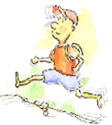Stress Intervention : Intrapersonal
 Purposes:
Purposes:
1. To introduce stress intervention: intrapersonal
2. To discuss positive and negative reactions towards stress
3. To teach relaxation techniques: progressive relaxation technique
Content
Stress Intervention: Intrapersonal
First of all, we have to identify our personal stressors to be either routine stressors (experienced often) or unique stressors (seldom encountered). Then, eliminate unnecessary stressors. Reduce the noise level of the environment is also a way to reduce stress level.
Besides, we have to have a balanced diet that provides a variety of nutrients (proteins, carbohydrates, fats, minerals, vitamins and water). We have to avoid the intake of pseudo stressors or sympathominetics, i.e. the food substances that can produce a stresslike response, e.g. tea, coffee, cola and chocolate. We have to limit the amount of saturated fats and alcohol; increase the amount of fiber and vegetables in our diet. We have to be more realistic about our weight because anorexia nervosa and bulimia may result from obsessive weight control. We have to add supplementary vitamins B and C during particular stressful situation.
Positive and Negative Reactions Towards Stress
We have to deal with stress positively : be optimistic, handle the problem directly, willing to solve it, search for new solution or seek help from others, do more exercise and take more rest in order to replenish yourself, and learn from failure. Conversely, we have to avoid negative reaction towards stress: be pessimistic, be trapped by the problem, do not seek new solution or help, smoking, drinking alcohol, taking drug, and become depressed due to failure.
Relaxation Technique
Progressive Relaxation Technique
When practising progressive relaxation, the environment should be free of noise, dime light and in room temperature. Switch off our mobile phone and pager, lie down or sit in a comfortable position, and then close our eyes. Students firstly contract a muscle group, feel the tension, and then relax that muscle group and feel the relaxation. They can relax muscles in the following order: arms, face, neck, shoulders, upper chest, stomach, lower back, hip, thighs and calves.
Class Activities
- Students can describe
their methods of handling stress.
- Teacher introduces intrapersonal
stress intervention and the relationship between stress and nutrition.
- Teacher introduces the
positive and negative reactions towards stress.
- Students practice progressive relaxation technique.
Teaching Materials
Lesson 2: Stress Psychophysiology
Lesson 4: Stress and Performance & Stress Intervention: Interpersonal
Please click here to download Stress Management text. (MS Word).